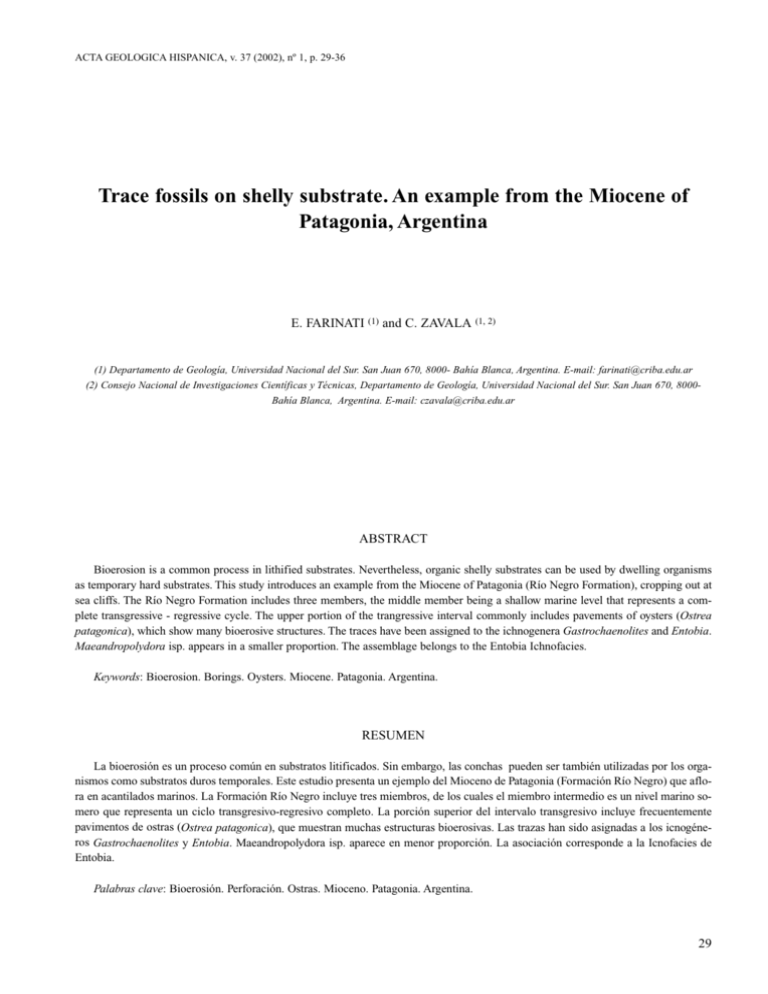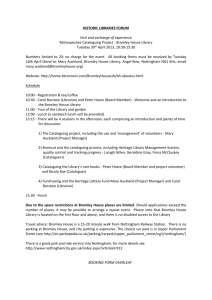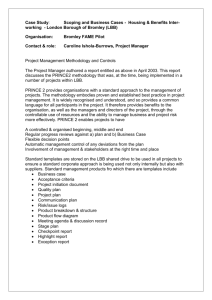Trace fossils on shelly substrate. An example from
advertisement

ACTA GEOLOGICA HISPANICA, v. 37 (2002), nº 1, p. 29-36 Trace fossils on shelly substrate. An example from the Miocene of Patagonia, Argentina E. FARINATI (1) and C. ZAVALA (1, 2) (1) Departamento de Geología, Universidad Nacional del Sur. San Juan 670, 8000- Bahía Blanca, Argentina. E-mail: farinati@criba.edu.ar (2) Consejo Nacional de Investigaciones Científicas y Técnicas, Departamento de Geología, Universidad Nacional del Sur. San Juan 670, 8000Bahía Blanca, Argentina. E-mail: czavala@criba.edu.ar ABSTRACT Bioerosion is a common process in lithified substrates. Nevertheless, organic shelly substrates can be used by dwelling organisms as temporary hard substrates. This study introduces an example from the Miocene of Patagonia (Río Negro Formation), cropping out at sea cliffs. The Río Negro Formation includes three members, the middle member being a shallow marine level that represents a complete transgressive - regressive cycle. The upper portion of the trangressive interval commonly includes pavements of oysters (Ostrea patagonica), which show many bioerosive structures. The traces have been assigned to the ichnogenera Gastrochaenolites and Entobia. Maeandropolydora isp. appears in a smaller proportion. The assemblage belongs to the Entobia Ichnofacies. Keywords: Bioerosion. Borings. Oysters. Miocene. Patagonia. Argentina. RESUMEN La bioerosión es un proceso común en substratos litificados. Sin embargo, las conchas pueden ser también utilizadas por los organismos como substratos duros temporales. Este estudio presenta un ejemplo del Mioceno de Patagonia (Formación Río Negro) que aflora en acantilados marinos. La Formación Río Negro incluye tres miembros, de los cuales el miembro intermedio es un nivel marino somero que representa un ciclo transgresivo-regresivo completo. La porción superior del intervalo transgresivo incluye frecuentemente pavimentos de ostras (Ostrea patagonica), que muestran muchas estructuras bioerosivas. Las trazas han sido asignadas a los icnogéneros Gastrochaenolites y Entobia. Maeandropolydora isp. aparece en menor proporción. La asociación corresponde a la Icnofacies de Entobia. Palabras clave: Bioerosión. Perforación. Ostras. Mioceno. Patagonia. Argentina. 29 E. FARINATI and C. ZAVALA INTRODUCTION GEOLOGICAL SETTING Bioerosion is widely considered as an important process affecting hard substrates, such as rock and wood. Many studies during recent years focused on inorganic hard substrates (Bromley, 1992, 1994; Martinell and Domènech, 1995; Gibert et al., 1998) resulting in a substantial improvement. Nevertheless, skeletal remains can act as hard substrates of small dimensions, where bioerosive activity can be very important (Martinell, 1989). The effect of bioerosive processes on shelly substrates has received attention from several authors (Martinell and Domènech, 1981; Martinell, 1982; Bromley and D´Alessandro, 1983, 1984; Bromley and Martinell, 1991). This contribution provides some ancient examples of bioerosion processes affecting large bivalves from the Miocene. The coastal outcrops under study were assigned to the Rio Negro Formation (Andreis, 1965), and interpreted as a mainly fluvial unit (Fig. 2). Recent studies by Zavala and Freije (2000) proposed a new origin and stratigraphic schema for the succession. These authors recognized, within the Rio Negro Formation, the existence of three uncorformity-bounded subunits or allomembers (hereafter abbreviated as "Members"). The Argentinian coastal zone located at the Northeast of Patagonia is a flat and arid steppe, where the only geological exposures are the well-developed sea cliffs (up to 65 meters high) (Fig. 1). A shallow marine level can be recognized near the base of the cliffs. It has a thickness of about 10 m and a lateral continuity of up to 50 km. This level was deposited in a partially confined shallow basin, affected by wave reworking processes. Bioclasts are locally abundant, including large specimens of Ostrea patagonica D´ORBIGNY. These bivalves appear isolated or forming pavements, on which endolithic bioerosive structures were observed. The lower member crops out with a missing base and it is composed of sandstones and mudstones deposited in a mainly aeolian paleoenvironment. The middle member unconformably overlies the lower member near the base of the cliffs and consists of marine deposits. The upper member consists of fine to medium grained sandstones and mudstones and sharply overlies the middle member. It was deposited in an aeolian depositional environment similar to that of the lower member. The marine level (middle member) is constituted by dark-grey mudstones and bioclastic sandstones recording a complete marine transgressive-regressive cycle deposited in a shallow and partially confined sea, with some evidences of wave reworking processes. According to its position in the sequence and to Potasium-Argon dating of equivalent marine deposits (9.41 My , Zinsmeister et al., 1981), the middle member was assigned to the Tortonian (Late Miocene). These marine deposits constitute a single depositional sequence, where a transgresssive and a highstand systems tracts were recognized (Fig. 3). In the uppermost portion of the sequence, a forced regression was recognized, probably related to a relative, rapid fall of sea level (Zavala and Freije, 2000). MATERIAL The material on which the present work is based comes from three localities: El Espigón, Playa Bonita and La Lobería (Figs. 1, 3). Figure 1. Location map of the studied sections. 30 Marine macrofossils are locally abundant and include bivalves as Chlamys tehuelchus, Podoesmus papyraceus, Ostrea patagonica, Chionopsis sp. and Dinocardium sp., Acta Geol. Hisp., v. 37 (2002), nº 1, p. 29-36 Miocene Bioerosion on Shells echinoidis as Monophoraster darwini, cirripedes as Balamus, and corals as Oculina singleyi. The highly bioturbated mudstones of lower shoreface-offshore settings yielded abundant valves of Ostrea patagonica whith many bioerosive structures. Oysters are epifaunal bivalves that possess a strongly inequivalve shell. They live at the intertidal-subtidal zone, cemented to the substrate to withstand the high energy of this environment and their irregular shape is often a function of this. As a dead epifauna, vital activity reflection of the organisms is showed in those that bear important areal extensions and coated zones (Mayoral, 1991). In this way, oysters can constitute organic, hard substrates, ideal to register the activity of boring organisms in search of dwelling. Because bioerosion is a self-destructive process, the sculpture it produces can only be preserved to the geologic record if it is buried under sediment (Bromley, 1994). Figure 2. Stratigraphic section of the study area. Apart from these bioerosive structures on oyster shells, another mechanism of taphonomic alteration is also common: the encrustation caused by epilithic orga- Figure 3. Correlation of measured sections and sequence stratigraphy of the Middle Member of the Rio Negro Formation. TST: Transgressive System Tract; HST: Highstand System Tract; mfs: maximum flooding surface; FR: Forced Regression. * Levels considered in this work. Acta Geol. Hisp., v. 37 (2002), nº 1, p. 29-36 31 E. FARINATI and C. ZAVALA 32 Acta Geol. Hisp., v. 37 (2002), nº 1, p. 29-36 Miocene Bioerosion on Shells nisms such as barnacles and corals. Oculina singleyi VAUGHAN is a colonial coral that encrusts on the valves of Ostrea patagonica (Plate II, fig. 7). This coral is composed of cylindrical corallites with strong ribs and circular, deep calices up to 3 mm of diameter, irregularly distributed on the external surface of oysters . The material used in this study is deposited at the Department of Geology, Universidad Nacional del Sur under (PI-UNS). TRACE FOSSIL DESCRIPTION Ichnogenus Gastrochaenolites LEYMERIE, 1842 Gastrochaenolites torpedo KELLY and BROMLEY, 1984 Plate I, figs. 1-8; Plate II, figs. 1-2 Description: Club-shaped, slightly elongate borings with circular cross-section. The borings are distributed in all available valve surface both in external and internal zones but mainly in the external surface (Plate I, figs. 1-5). Usually, the borings appear where the shell is thicker (Plate I, fig. 6). Some borings are produced approximately normal to the surface, while others are parallel to the surface of the valve or located in the edge (Plate I, fig. 7). The internal surface of the borings may be smooth or may show a sculpture consisting on concentric lines or rugae (Plate I, fig. 8; Plate II, fig. 1). Sediment filled borings or internal molds of the holes are commonly preserved, revealing the three-dimensional morphology of the structure (Plate II, fig. 2). Dimensions: Sizes varying between 10 and 35 mm in length; 5 and 12 mm of width. Remarks: These borings are assigned to boring bivalves with a behavior based on the search of refuge or dwelling (domichnia), and they are attributed to the ichnogenus Gastrochaenolites LEYMERIE, 1842. Ichnospecies of Gastrochaenolites are generally shallow-water trace fossils, and where individuals are crowded and dominate the assemblage, only a few meters of water may be inferred (Bromley, 1994). According to the boring morphology given by Kelly and Bromley (1984) -oval apertural form, neck region markedly compressed, circular cross-section, base of boring acutely parabolic- the studied material could correspond to the ichnospecies Gastrochaenolites torpedo KELLY and BROMLEY, 1984. Bromley and D´Alessandro (1987) stated that Gastrochaenolites torpedo corresponds precisely to the work of Lithophaga lithophaga, one of the most abundant and best known mytilid borers, largely confined to calcareous substrates. These type of borings are made by bivalves of Family Mytilidae which, by means of an acid organic secretion, bore holes to dwell inside. In the study area, modern borings similar to Gastrochaenolites are known in the Atlantic coast and they are produced by Lithophaga patagonica (D´ORBIGNY, 1846). However, it is not possible to attribute the studied Gastrochaenolites to the same species because they do not contain fossil shells of their producers. Occurrence: Very abundant at La Lobería and Playa Bonita. Ichnogenus Entobia BRONN, 1837 Plate II, figs. 3-7 Description: Camerate entobian composed of networks of chambers arranged parallel to the external oyster shell. Apertures of distinct sizes differing within the Plate I 1. Ostrea patagonica with borings of Gastrochaenolites torpedo on the external surface. From El Espigón. PI-UNS 3020. 2. Intensely bored external surface of an oyster. From La Lobería. PI- UNS 3024. 3. Detail of the umbonal area borings. From La Lobería. PI-UNS 3023. 4. Internal surface of Ostrea patagonica. From La Lobería. PI-UNS 3025. 5. Internal surface of an oyster. From Playa Bonita. PI-UNS 3022. 6. Gastrochaenolites torpedo where the shell is thicker. From Playa Bonita. PI-UNS 3028. 7. Gastrochaenolites torpedo in the ventral edge. From Playa Bonita. PI-UNS 3027. 8. Internal surface of Gastrochaenolites torpedo showing a sculpture of concentric lines or rugae. From Playa Bonita. PI-UNS 3021. Scale bar: 1 cm Acta Geol. Hisp., v. 37 (2002), nº 1, p. 29-36 33 E. FARINATI and C. ZAVALA 34 Acta Geol. Hisp., v. 37 (2002), nº 1, p. 29-36 Miocene Bioerosion on Shells same sample; the larger are circular and variable in diameter; the smaller spread among the larger ones. The shape of the chambers varies from subrounded to subrectangular. Intercameral walls between neighbouring chambers. Thus, fusion does not occur (Plate II, fig. 3). Dimensions: Aperture diameter ranging between 0.5 and 2.5 mm. Remarks: Entobian forms are the work of endolithic sponges. Similar borings are produced nowadays by several species of Cliona (Bromley and D´Alessandro, 1989). On the basis of their three dimensional configuration, many entobian ichnospecies have been recognized, but in this case identification has not been possible. Nevertheless, Entobia geometrica BROMLEY and D´ALESSANDRO from the Pliocene of the Gravina Formation (Bromley and D´Alessandro, 1984) is closely similar to our material. Occurrence: Numerous specimens at El Espigón, Playa Bonita and La Lobería. Ichnogenus Maeandropolydora VOIGT, 1965 Plate II, figs. 6, 8 Description: Long, shallow and sinuous borings that extend as U-shaped pouches. Pouches tend to run parallel with a tendency for a symmetrical mode of growth of these (Plate II, fig. 8). Dimensions: Lenght: 10-20 mm; diameter: 1-1.5 mm. Remarks: These borings are produced by polychaete annelids of various families (Bromley and D´Alessandro, 1983). On the basis of their close similarity in morphology and size, they may be tentatively assigned to Maeandropolydora barocca BROMLEY and D´ALESSANDRO. Occurrence: At La Lobería and Playa Bonita. CONCLUSIONS The study of the borings recorded on valves of Ostrea patagonica at the north-east of Patagonia suggests that most of them were produced after death of the host in disarticulated valves, both at their external and internal surfaces. Although these valves are immerse in finegrained sediments, they could have constituted subaqueous shell pavements that could have been suitable to host boring organisms. In the case study, bioerosion activity was enhanced by very low depositional rates, associated to an overall transgressive tendency. Consequently, fossil asemblages of valves of Ostrea patagonica can locally constitute organic, hard substrates where the ichnogenus Gastrochaenolites and others can effectively develop. It must be noted that in the present work, these temporary shelly substrates are considered in the same way to that of the truly lithified substrates. The trace fossil assemblage described herein is dominated by the ichnogenera Gastrochaenolites and Entobia, which often are accompanied by worm borings such as Maeandropolydora. This assemblage belongs to the Entobia Ichnofacies as defined by Bromley and Asgaard (1993). The presence of the Gastrochaenolites-Entobia assemblage is clearly observed. It is typical of Neogene and with major or minor variations has been recorded since to the Jurassic at least in rocky shores (Gibert et al., 1998). The level with bored oysters is related to a quick transition between shoreface-offshore facies registered within the transgressive systems tract (TST). Regional data, supported by the correlation of several detailed sections (Zavala and Freije, 2000), indicate that the water depth never exceeded 15 meters, within a partially confined basin. Consequently, the passage from shore- Plate II 1. Internal surface of a oyster shell fragment with borings of Gastrochaenolites torpedo. From La Lobería. PI-UNS 3019. 2. Oyster with three filled Gastrochaenolites torpedo. From Playa Bonita. PI-UNS 3026. 3. Gastrochaenolites-Entobia assemblage. From El Espigón. PI-UNS 3029. 4. Small and numerous Entobia borings. From La Lobería. PI-UNS 3030. 5. Gastrochaenolites and Entobia. From La Lobería. PI-UNS 3031. 6. Gastrochaenolites, Entobia and Maeandropolydora. From La Lobería. PI-UNS 3032. 7. Gastrochaenolites, Entobia and encrustation by Oculina singleyi. From El Espigón. PI-UNS 3033. 8. Maendropolydora on external surface of oyster. From La Lobería. PI-UNS 3034. Scale bar: 1 cm Acta Geol. Hisp., v. 37 (2002), nº 1, p. 29-36 35 E. FARINATI and C. ZAVALA face – offshore conditions occurred at very shallow positions, and was related to the landward shift in facies during the TST, without a substantial increase in the water level. ACKNOWLEDGMENTS The authors are most grateful to reviewer Dr. Jordi M. de Gibert for their helpful comments on the manuscript. REFERENCES Andreis, R.R., 1965. Petrografía y paleocorrientes de la Formación Río Negro (tramo General Conesa-boca del Río Negro). Revista del Museo de La Plata, 5, Geología 36, 245310. Bromley, R.G., 1992. Bioerosion: eating rocks for fun and profit. In C.G. Maples, R.R. West (eds.). Trace Fossils. Paleontological Society, Short Courses in Paleontology, 5: 121129. Bromley, R.G., 1994. The palaeocology of bioerosion. In S.K. Donovan (ed.). The paleobiology of trace fossils. John Wiley & Sons, Chichester, 5, 134-154. Bromley, R.G., Asgaard, U., 1993. Two bioerosion ichnofacies produced by early and late burial associated with sea-level change. Geologische Rundschau, 82, 276-280. Bromley, R.G., D´Alessandro, A., 1983. Bioerosion in the Pleistocene of southern Italy: ichnogenera Caulostrepsis and Maeandropolydora. Rivista Italiana di Paleontologia e Stratigrafia, 89(2), 283-309. Bromley, R.G., D´Alessandro, A., 1984.The ichnogenus Entobia from the Miocene, Pliocene and Pleistocene of southern Italy. Rivista Italiana di Paleontologia e Stratigrafia, 90(2), 227-296. Bromley, R.G., D´Alessandro, A., 1987. Bioerosion of the Plio- 36 Pleistocene transgression of southern Italy. Rivista Italiana di Paleontologia e Stratigrafia, 93(3), 379-442. Bromley, R.G., D´Alessandro, A., 1989. Ichnological study of shallow marine endolithic sponges from the Italian coast. Rivista Italiana di Paleontologia e Stratigrafia, 95, 279314. Bromley, R.G., Martinell, J. 1991. Centrichnus, new ichnogenus for centrically patterned attachment scars on skeletal substrates. Bulletin of the Geological Society of Denmark, 38, 243-252. Gibert, J.M. de, Martinell, J., Domènech, R., 1998. Entobia ichnofacies in fossil rocky shores, Lower Pliocene, Northwestern Mediterranean. Palaios, 13(5), 476-487. Kelly, S.R., Bromley, R.G., 1984. Ichnological nomenclature of clavate borings. Paleontology, 27, 793-807. Martinell, J., 1982. Echinoid bioerosion from the Pliocene of NE Spain. Geobios, 15(2), 249-253. Martinell, J., 1989. Interacción organismos/sustrato duro: la bioerosión y sus implicaciones. In E. Aguirre (ed.). Paleontología, Colección "Nuevas Tendencias", 205-222. Martinell, J., Domènech, R., 1981. Boring activity of Epibionts in a Early Holocene molluscan fauna of Spanish Catalunya. Acta Geologica Hispanica, 16(3), 145-149. Martinell, J., Domènech, R., 1995. Bioerosive structures on the Pliocene rocky shores of Catalonia (Spain). Revista Española de Paleontología, 10(1), 37-44. Mayoral, E., 1991. Caulostrepsis contorta Bromley & D´Alessandro. Nuevas aportaciones al estudio de los fenómenos bioerosivos en el Plioceno del Bajo Guadalquivir. Revista Española de Paleontología, Nº Extraordinario, 53-60. Zavala, C., Freije H., 2000. Estratigrafía secuencial del Terciario superior marino de Patagonia. Posibles relaciones con la crisis del Messiniano. Geotemas 1(2), 217-221. Zinsmeister, W.J., Marshall, L.G., Drake, R.E., Curtis, G.H., 1981. First Radioisotope (Potassium-Argon) Age of Marine Neogene Rionegro Beds in Northeastern Patagonia, Argentina. Science, 212, 440. Acta Geol. Hisp., v. 37 (2002), nº 1, p. 29-36








